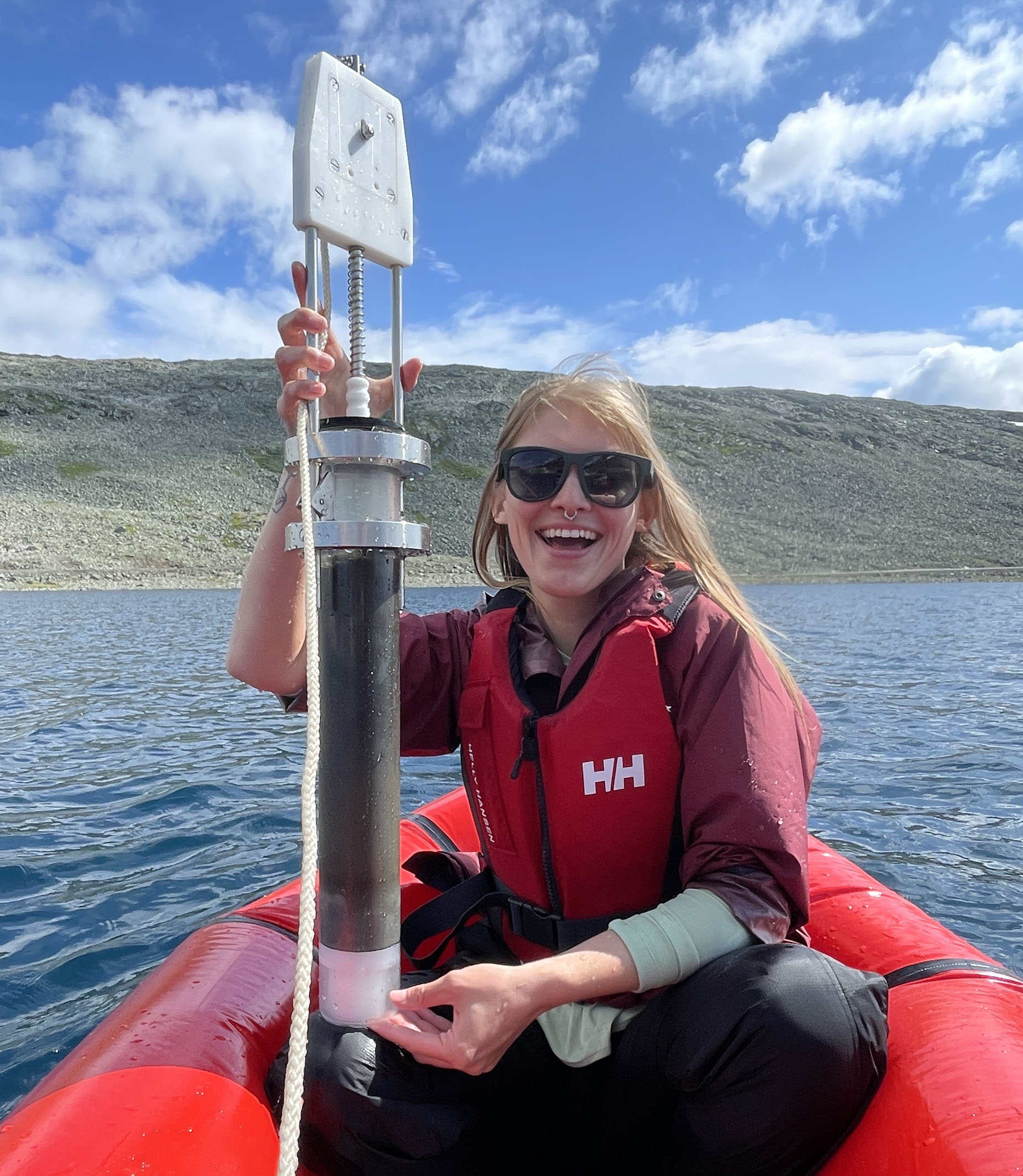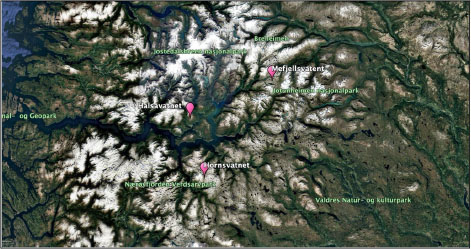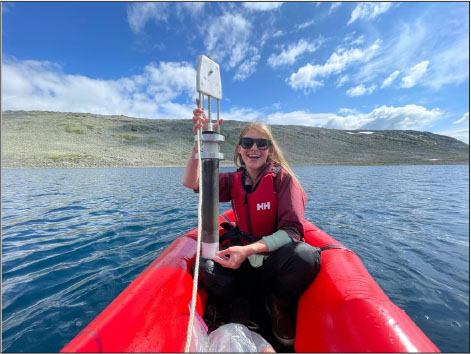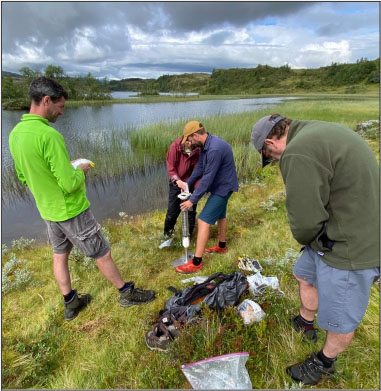
Investigating lake browning in central Norway following long-term acid deposition Expedition location: Sogndal, Norway
Expedition Dates: July 27th, 2025 – August 8th, 2025
Field Team Members: Kayla Guthrie, Miranda Seixas, Dr. Jasmine Saros, Dr. Jacob Yde, Dr. Torgeir Røthe, Dr. Sigurd Nerhus, and Misa Saros
Funding Support: The Robert and Judith Sturgis Family Foundation
Research Background:
Acid deposition has had significant impacts in Norway, leaving forests, lakes, and rivers heavily acidified. Policy implementation, however, has reduced the industrial emissions contributing to sulfate and nitrate deposition. While these systems are recovering from decreased acidification, lakes across Europe and North America are browning. This process is known as brownification and it is the result of enhanced terrestrial weathering. Lake brownification can occur from increased levels of dissolved organic matter, specifically dissolved organic carbon, or DOC, but it may also occur from increased levels of iron. DOC most notably gives the lake a brown appearance as it contains humic substances. This browning of the water column limits the availability of light to depth, and can significantly impact the productivity of the system.
Additionally, climate factors such as temperature and precipitation can increase DOC in surface waters, with large precipitation events having a strong influence on DOC concentrations (Gavin et al. 2018). However, projections for future DOC trends remain uncertain with more variable regional climates, although lakes in Central Norway show influence from both extreme warming and cooling trends (Curtis, 2009).
In addition to browning, recovering lakes in Norway are experiencing elevated levels of total organic nitrogen, or TON, in surface waters, highlighting a shift in nutrient balance (Deininger et al. 2020). Shifts from inorganic to organic nitrogen ratios indicate changes in bioavailable nitrogen, a key nutrient for cellular growth and maintenance. Interestingly, in the presence of elevated DOC, microbes may alleviate nitrogen stress in diatoms by providing readily available forms other than nitrate (Diner et al. 2016). This balance between elevated DOC and TON and its collaborative impact on community function is not well understood.
Lakes at higher elevations are highly sensitive to changes in environmental conditions, and serve as an early warning system for broader changes in climate. Contemporary monitoring of lakes observes current changes in lake conditions, whereas sediment cores allow us to observe changes in lake conditions over time. As lake sediment accumulates, material such as organic debris, minerals, and chemical precipitates are buried. Isotope composition and diatom frustules, the silica cell walls of diatoms, are key components of sediment that tell us about intricate changes in environmental conditions. Nitrogen isotope composition is highly useful in determining the source of nitrogen, whether from a terrestrial source such as soils or from anthropogenic sources. Since diatoms are highly sensitive to changes in water quality they are a reliable metric to interpret lake conditions. This research project aims to understand how these changes in lake conditions, particularly when it comes to nutrients such as nitrogen and carbon, impact the ecosystem.

Study Site: Field work was conducted across three lakes in Central Norway, Halsavatnet, Hornsvatnet, and Mefjellsvatnet, shown in Figure 1. A previous research project surveyed lakes across Norway for water chemistry and diatom assemblages (Clarke, 2001). From this survey, the three lakes Halsavatnet, Hornsavatnet, and Mefjellsvatnet were selected. Halsavatnet is a lake with expansive vegetation cover in the watershed, whereas Hornsvatnet and Mefjellsvatnet have very little vegetation in the watershed. All of the lakes are in close proximity to Jostedalsbreen and are influenced by this climate.

Methods: To address the question, sediment cores were collected from three lakes in central Norway using a gravity corer, shown in Figure 2. On the lake shore, each core was sliced at half centimeter intervals throughout. Samples were then transported back to the University of Maine for analysis. Diatom frustules were extracted from sediment and prepped for slides to analyze under the microscope to understand how conditions in the lake have changed over time.

Sediment was also weighed and dried for a full 24-hours at 100℃ to determine water content. From the dried sediment, samples were weighed out and sent to St. Croix Watershed Research Station for 210Pb dating and sent to the University of California Davis Stable Isotope Lab for 15N isotope analysis. Water chemistry and nutrient samples will be run at the University of Maine Sawyer Water Research Laboratory.
Acknowledgements: Financial support for this field work was generously provided by the Robert and Judith Sturgis Family Foundation. Additionally, this field work would not have been possible without the support of my team members (Figure 3) and special guidance from Dr. Jacob Yde and my advisor, Dr. Jasmine Saros. A special thank you to Miranda Seixas for assistance in the boat.
References:
Clarke, G. (2003). The relationship between diatoms and climate in a European mountain lake training set: Implications for detecting the Little Ice Age in lake sediments from Central Norway. [Doctoral dissertation, University College London]. ProQuest Dissertations and Theses Database.
Curtis, C. J., Juggins, S., Clarke, G., Battarbee, R. W., Kernan, M., Catalan, J., Thompson, R., & Posch, M. (2009). Regional influence of acid deposition and climate change in Europeanmountain lakes assessed using diatom transfer functions. Freshwater Biology, 54(12), 2555–2572. https://doi.org/10.1111/j.1365-2427.2009.02317.x
Deininger, A., Kaste, Ø., Frigstad, H., & Austnes, K. (2020). Organic nitrogen steadily increasing in Norwegian rivers draining to the Skagerrak coast. Scientific Reports, 10(1), 18451.https://doi.org/10.1038/s41598-020-75532-5
Diner, R. E., Schwenck, S. M., McCrow, J. P., Zheng, H., & Allen, A. E. (2016). Genetic Manipulation of Competition for Nitrate between Heterotrophic Bacteria and Diatoms. Frontiers in Microbiology, 7. https://doi.org/10.3389/fmicb.2016.00880
Gavin, A. L., Nelson, S. J., Klemmer, A. J., Fernandez, I. J., Strock, K. E., & McDowell, W. H. (2018). Acidification and climate linkages to increased dissolved organic carbon in high- elevation lakes. Water Resources Research, 54, 5376–5393. https://doi.org/10.1029/2017WR020963

